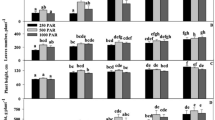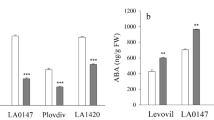Abstract
Little is known about the light regulation of vitamin C synthesis in fruits. In contrast, previous studies in leaves revealed that VTC2 (coding for GDP-l-galactose phosphorylase) was one of the key genes up-regulated by light in leaves. Our objective was to determine how the expression of ascorbate (AsA) synthesis genes in tomato (Solanum lycopersicum) was modified according to light irradiance in both leaves and fruits. Seven days of shading strongly decreased total ascorbate (reduced and oxidized form) content in leaves (50%) and to a lesser extent in fruits (10%). Among the last six steps of AsA biosynthesis, only two genes, VTC2 and GPP1 (one of the two unigenes coding for l-galactose-1-P phosphatase in tomato), were down-regulated by long-term shading in red ripe fruits, compared to seven genes regulated in leaves. This underlines that light affects AsA-related gene expression more in leaves than in ripening fruits. Moreover, this study reveals strong daily changes in transcript levels of enzymes of the AsA biosynthetic pathway in leaves (11 of the 12 studied genes showed significant changes in their expression pattern). Among those genes, we found that diurnal variation in transcript levels of VTC2 and GME1 correlated to leaf AsA content measured 8 h later. This study provides a new hypothesis on the role of GME1 in addition to VTC2 in light-regulated AsA biosynthesis.







Similar content being viewed by others
Abbreviations
- AsA:
-
Ascorbate
- DHA:
-
Dehydroascorbate
- Fv/Fm:
-
Maximum quantum efficiency of PSII
- GMP:
-
GDP-d-mannose pyrophosphorylase
- GME:
-
GDP-d-mannose 3′,5′-epimerase
- GGP:
-
GDP-l-galactose phosphorylase
- GPP:
-
l-galactose-1-P phosphatase
- l-GalDH:
-
l-galactose dehydrogenase
- GLDH:
-
l-galactono-1,4-lactone dehydrogenase
- PAR:
-
Photosynthetically active radiation
- PSII:
-
Photosystem II
- RT-QPCR:
-
Real-time quantitative polymerase chain reaction
- T-AsA:
-
Total ascorbate (AsA + DHA)
- UT:
-
Universal time
- WVA106:
-
Tomato cultivar West Virginia 106
References
Alhagdow M, Mounet F, Gilbert L, Nunes-Nesi A, Garcia V, Just D, Petit J, Beauvoit B, Fernie AR, Rothan C, Baldet P (2007) Silencing of the mitochondrial ascorbate synthesizing enzyme l-galactono-1,4-lactone dehydrogenase affects plant and fruit development in tomato. Plant Physiol 145:1408–1422
Asada K (1999) The water–water cycle in chloroplasts: scavenging of active oxygens and dissipation of excess photons. Annu Rev Plant Physiol Plant Mol Biol 50:601–639
Badejo AA, Tanaka N, Esaka M (2008) Analysis of GDP-d-mannose pyrophosphorylase gene promoter from acerola (Malpighia glabra) and increase in ascorbate content of transgenic tobacco expressing the acerola gene. Plant Cell Physiol 49:126–132
Bartoli CG, Pastori GM, Foyer CH (2000) Ascorbate biosynthesis in mitochondria is linked to the electron transport chain between complexes iii and iv. Plant Physiol 123:335–343
Bartoli CG, Tambussi EA, Diego F, Foyer CH (2009) Control of ascorbic acid synthesis and accumulation and glutathione by the incident light red/far red ratio in Phaseolus vulgaris leaves. FEBS Lett 583:118–122
Chen Z, Gallie DR (2004) The ascorbic acid redox state controls guard cell signaling and stomatal movement. Plant Cell 16:1143–1162
Conklin PL, Norris SR, Wheeler GL, Williams EH, Smirnoff N, Last RL (1999) Genetic evidence for the role of GDP-mannose in plant ascorbic acid (vitamin C) biosynthesis. Proc Natl Acad Sci USA 96:4198–4203
Demmig-Adams B, Adams WW (1996) The role of xanthophyll cycle carotenoids in the protection of photosynthesis. Trends Plant Sci 1:21–26
Dowdle J, Ishikawa T, Gatzek S, Rolinski S, Smirnoff N (2007) Two genes in Arabidopsis thaliana encoding GDP-l-galactose phosphorylase are required for ascorbate biosynthesis and seedling viability. Plant J 52:673–689
El-Gizawi AM, Abdallah MMF, Gomaa HM, Mohamed SS (1993) Effect of different shading levels on tomato plants. 2. Yield and fruit quality. Acta Hort 323:349–354
Gatzek S, Wheeler GL, Smirnoff N (2002) Antisense suppression of l-galactose dehydrogenase in Arabidopsis thaliana provides evidence for its role in ascorbate synthesis and reveals light modulated l-galactose synthesis. Plant J 30:541–553
Gautier H, Massot C, Stevens R, Serino S, Génard M (2009) Regulation of tomato fruit ascorbate content is more highly dependent on fruit irradiance than leaf irradiance. Ann Botany 103:495–504
Gilbert L, Alhagdow M, Nunes-Nesi A, Quemener B, Guillon F, Bouchet B, Faurobert M, Gouble B, Page D, Garcia V, Petit J, Stevens R, Causse M, Fernie AR, Lahaye M, Rothan C, Baldet P (2009) GDP-d-mannose 3,5-epimerase (GME) plays a key role at the intersection of ascorbate and non-cellulosic cell-wall biosynthesis in tomato. Plant J 60:499–508
Hamner KC, Bernstein L, Maynard LA (1945) Effects of light intensity, day length, temperature, and other environmental factors on the ascorbic acid content of tomatoes. J Nutr 29:85–97
Hancock RD, McRae D, Haupt S, Viola R (2003) Synthesis of l-ascorbic acid in the phloem. BMC Plant Biol 3:1080–1091
Hancock RD, Walker PG, Pont SDA, Marquis N, Vivera S, Gordon SL, Brennan RM, Viola R (2007) l-ascorbic acid accumulation in fruit of Ribes nigrum occurs by in situ biosynthesis via the l-galactose pathway. Funct Plant Biol 34:1080–1091
Handa AK, Singh NK, Biggs MS (1985) Effect of tunicamycin on in vitro ripening of tomato pericarp tissue. Physiol Plant 63:417–424
Ioannidi E, Kalamaki MS, Engineer C, Pateraki I, Alexandrou D, Mellidou I, Giovannonni J, Kanellis AK (2009) Expression profiling of ascorbic acid-related genes during tomato fruit development and ripening and in response to stress conditions. J Exp Bot 60:663–678
Krause GH, Weis E (1991) Chlorophyll fluorescence and photosynthesis: the basics. Annu Rev Plant Physiol Plant Mol Biol 42:313–349
Kuzniak E (2004) Ascorbate and ascorbate-dependent enzymes in detached tomato leaves under conditions modulating the ascorbate pool. Acta Physiol Plant 26:327–333
Laing WA, Wright MA, Cooney J, Bulley SM (2007) The missing step of the l-galactose pathway of ascorbate biosynthesis in plants, an l-galactose guanyltransferase, increases leaf ascorbate content. Proc Natl Acad Sci USA 104:9534–9539
Li Y, Ren X, Song Y, Hou X (2008) Enhancement of GLDHase activity by light in maintaining AsA content in leaves of Brassica campestris ssp. Chinensis. In: proceedings of international symposium on endogenous and exogenous plant bioregulators, IHC 2006, Seoul, Korea, 13–19 August 2006., 2008. Int Soc for Horticultural Science (ISHS), pp 403–408
Li M, Ma F, Shang P, Zhang M, Hou C, Liang D (2009) Influence of light on ascorbate formation and metabolism in apple fruits. Planta 230:39–51
Li M, Gao J, Ma F, Liang D, Hou C (2010) Relationship between expressions of GaLDH and GaLLDH and ascorbate content in apple fruits. Sci Agric Sinica 43:351–357
Linster CL, Clarke SG (2008) l-ascorbate biosynthesis in higher plants: The role of vtc2. Trends Plant Sci 13:567–573
Linster CL, Adler LN, Webb K, Christensen KC, Brenner C, Clarke SG (2008) A second GDP-l-galactose phosphorylase in Arabidopsis en route to vitamin C: covalent intermediate and substrate requirements for the conserved reaction. J Biol Chem 283:18483–18492
Livak KJ, Schmittgen TD (2001) Analysis of relative gene expression data using real-time quantitative PCR and the 2 −ΔΔCT method. Methods 25:402–408
Madamba LSP, Morales ER, Villanueva TG (1974) Some factors affecting the ascorbic acid contents of tomato fruits. Philippine J Nutr 27:7–12
Maruta T, Yonemitsu M, Yabuta Y, Tamoi M, Ishikawa T, Shigeoka S (2008) Arabidopsis phosphomannose isomerase 1, but not phosphomannose isomerase 2, is essential for ascorbic acid biosynthesis. J Biol Chem 283:28842–28851
Massot C, Génard M, Stevens R, Gautier H (2010) Fluctuations in sugar content are not determinant in explaining variations in vitamin C in tomato fruit. Plant Physiol Biochem 48:751–757
Mc Collum J (1946) Effect of sunlight exposure on the quality of constituents of tomato fruits. Proc Am Soc Hort Sci 48:413–416
Pallanca JE, Smirnoff N (2000) The control of ascorbic acid synthesis and turnover in pea seedlings. J Exp Bot 51:669–674
Pignocchi C, Fletcher JM, Wilkinson JE, Barnes JD, Foyer CH (2003) The function of ascorbate oxidase in tobacco. Plant Physiol 132:1631–1641
Razavi F, Keulemans J, Davey MW (2005) A study of the l-ascorbate biosynthetic capacity of apple fruit. Commun Agric Appl Biol Sci 70:213–216
Smirnoff N (2000) Ascorbate biosynthesis and function in photoprotection. Philos Trans R Soc Lond B Biol Sci 355:1455–1464
Stevens R, Buret M, Garchery C, Carretero Y, Causse M (2006) Technique for rapid, small-scale analysis of vitamin C levels in fruit and application to a tomato mutant collection. J Agric Food Chem 54:6159–6165
Tabata K, Takaoka T, Esaka M (2002) Gene expression of ascorbic acid-related enzymes in tobacco. Phytochemistry 61:631–635
Tamaoki M, Mukai F, Asai N, Nakajima N, Kubo A, Aono M, Saji H (2003) Light-controlled expression of a gene encoding l-galactono-gamma-lactone dehydrogenase which affects ascorbate pool size in Arabidopsis thaliana. Plant Sci 164:1111–1117
Tedone L, Hancock R, Alberino S, Haupt S, Viola R (2004) Long-distance transport of l-ascorbic acid in potato. BMC Plant Biol 4:16
Wheeler GL, Jones MA, Smirnoff N (1998) The biosynthetic pathway of vitamin C in higher plants. Nature 393:365–369
Yabuta Y, Mieda T, Rapolu M, Nakamura A, Motoki T, Maruta T, Yoshimura K, Ishikawa T, Shigeoka S (2007) Light regulation of ascorbate biosynthesis is dependent on the photosynthetic electron transport chain but independent of sugars in Arabidopsis. J Exp Bot 58:2661–2671
Yabuta Y, Maruta T, Nakamura A, Mieda T, Yoshimura K, Ishikawa T, Shigeoka S (2008) Conversion of l-galactono-1,4-lactone to l-ascorbate is regulated by the photosynthetic electron transport chain in Arabidopsis. Biosci Biotechnol Biochem 72:2598–2607
Zhou Y, Zhang Y, Zhao X, Yu H, Shi K, Yu J (2009) Impact of light variation on development of photoprotection, antioxidants, and nutritional value in Lactuca sativa L. J Agric Food Chem 57:5494–5500
Acknowledgments
We are grateful to the greenhouse experimental team and to Yolande Carretero for taking care of the plants. We thank Claude Courbet and Michel Pradier for fruit harvesting, Cécile Garchery and Louise Gilbert for technical support in Q-PCR analyses and Grazielle Faure, Emilie Rubio, Sylvie Sérino and Doriane Bancel for vitamin C and sugar assays. Finally, we thank Valentina Baldazzi for critical reading of the manuscript.
Author information
Authors and Affiliations
Corresponding author
Electronic supplementary material
Below is the link to the electronic supplementary material.
The following materials are available in the online version of this article.
Supplemental Fig. S1 Photosynthetically active radiation measured during the two experiments
Supplemental Fig. S2 Relation between T-AsA content and Fv/Fm ratio in leaves in the diurnal experiment
Supplemental Fig. S3 Daily variations of T-AsA content in green mature and red ripe fruits
Supplemental Fig. S4 Relative abundances of AsA-related mRNAs in S. lycopersicum ‘WVa 106’ leaves during a sunny or a cloudy day at midday.
Supplemental Fig. S5 Correlation between relative VTC2 and GME1 mRNA abundance and T-AsA content 8 h later
Supplemental Table S1 PCR primers used to amplify specific regions of genes of interest
Rights and permissions
About this article
Cite this article
Massot, C., Stevens, R., Génard, M. et al. Light affects ascorbate content and ascorbate-related gene expression in tomato leaves more than in fruits. Planta 235, 153–163 (2012). https://doi.org/10.1007/s00425-011-1493-x
Received:
Accepted:
Published:
Issue Date:
DOI: https://doi.org/10.1007/s00425-011-1493-x




